Research on Social-Ecological Resilience Assessment of Rural Settlements in Typical Mountainous Areas of Southwest China Based on the Coordination of Kernel and Peripheral Systems
Abstract
1. Introduction
2. Data and Methods
2.1. Study Area
2.2. Data Sources
2.3. Research Methods
2.3.1. Social-Ecological Resilience Connotation Characteristics of Rural Settlements
2.3.2. Evaluation Index System of Settlement Social-Ecological Resilience Level
2.3.3. Standardization of the Indicator System
2.3.4. Determination of the Indicator Weights
2.3.5. Integration of the Kernel System and Peripheral System Resilience to Determine the Integrated Social-Ecological Resilience Level of Rural Settlements
3. Results
3.1. The Current Situation of Rural Settlements in the Study Area
3.2. Social-Ecological Resilience Level of Rural Settlements in the Study Area
3.2.1. Social-Ecological Resilience Level of Kernel System
3.2.2. Social-Ecological Resilience Level of Peripheral Systems
3.2.3. Comprehensive Social-Ecological Resilience Level
4. Discussions and Policy Implications
4.1. Mechanistic Analysis of Social-Ecological Resilience in Rural Settlements
4.2. Optimization Path of the Spatial Layout of Rural Settlements
4.2.1. Kernel Structure Optimization
4.2.2. Upgraded Peripheral System
4.2.3. Relocation & Annexation
4.3. Limitations of Applying Social-Ecological Resilience Theory to Rural Research
5. Conclusions
Author Contributions
Funding
Data Availability Statement
Conflicts of Interest
References
- Liu, Y.; Li, Y. Revitalize the world’s countryside. Nature 2017, 548, 275–277. [Google Scholar] [CrossRef]
- Li, Y.; Westlund, H.; Liu, Y. Why some rural areas decline while some others not: An overview of rural evolution in the world. J. Rural. Stud. 2019, 68, 135–143. [Google Scholar] [CrossRef]
- Ma, W.; Zhu, D.; Jiang, G. Research on land use structure transition of rural settlements facing the rural vitalization. Geogr. Res. 2022, 41, 2615–2630. [Google Scholar] [CrossRef]
- Zhang, Y.; Wang, J.; Liu, Y. Regional function transformation and high-quality development path in Qinling-Daba Mountains of Shaanxi province. J. Nat. Resour. 2021, 36, 2464–2477. [Google Scholar] [CrossRef]
- Li, H. Rural settlements research from the perspective of resilience theory. Sci. Geogr. Sin. 2020, 40, 556–562. [Google Scholar] [CrossRef]
- Wilson, G.A.; Hu, Z.; Rahman, S. Community resilience in rural China: The case of Hu Village, Sichuan Province. J. Rural. Stud. 2018, 60, 130–140. [Google Scholar] [CrossRef]
- Qiu, M.; Liu, D.; Liu, Y. Review on theoretical framework and evaluation system of rural resilience. China Land Sci. 2021, 35, 107–114. [Google Scholar] [CrossRef]
- Hong, B.; Bonczak, B.J.; Gupta, A.; Kontokosta, C.E. Measuring inequality in community resilience to natural disasters using large-scale mobility data. Nat. Commun. 2021, 12, 1870. [Google Scholar] [CrossRef]
- Sun, Y.; Zhang, L.; Yao, S. Evaluating resilience of prefecture cities in the Yangtze River delta region from a socio-ecological perspective. China Popul. Resour. Environ. 2017, 27, 151–158. [Google Scholar] [CrossRef]
- Assumma, V.; Bottero, M.; De Angelis, E.; Lourenço, J.M.; Monaco, R.; Soares, A.J. A decision support system for territorial resilience assessment and planning: An application to the Douro Valley (Portugal). Sci. Total Environ. 2021, 756, 143806. [Google Scholar] [CrossRef]
- Fahad, S.; Hossain, M.S.; Huong, N.T.L.; Nassani, A.A.; Haffar, M.; Naeem, M.R. An assessment of rural household vulnerability and resilience in natural hazards: Evidence from flood prone areas. Environ. Dev. Sustain. 2023, 25, 5561–5577. [Google Scholar] [CrossRef]
- Modica, M.; Reggiani, A. Spatial Economic Resilience: Overview and Perspectives. Netw. Spat. Econ. 2015, 15, 211–233. [Google Scholar] [CrossRef]
- Parsons, M.; Reeve, I.; McGregor, J.; Hastings, P.; Marshall, G.R.; McNeill, J.; Stayner, R.; Glavac, S. Disaster resilience in Australia: A geographic assessment using an index of coping and adaptive capacity. Int. J. Disaster Risk Reduct. 2021, 62, 102422. [Google Scholar] [CrossRef]
- Shi, Y.; Zhai, G.; Xu, L.; Zhou, S.; Lu, Y.; Liu, H.; Huang, W. Assessment methods of urban system resilience: From the perspective of complex adaptive system theory. Cities 2021, 112, 103141. [Google Scholar] [CrossRef]
- Parsons, M.; Glavac, S.; Hastings, P.; Marshall, G.; McGregor, J.; McNeill, J.; Morley, P.; Reeve, I.; Stayner, R. Top-down assessment of disaster resilience: A conceptual framework using coping and adaptive capacities. Int. J. Disaster Risk Reduct. 2016, 19, 1–11. [Google Scholar] [CrossRef]
- Folke, C. Resilience: The emergence of a perspective for social-ecological systems analyses. Glob. Environ. Change-Hum. Policy Dimens. 2006, 16, 253–267. [Google Scholar] [CrossRef]
- Li, Y.; Lin, J.; Li, Y.; Nyerges, T. Developing a resilience assessment framework for the Urban Land-Water System. Land Degrad. Dev. 2019, 30, 1107–1120. [Google Scholar] [CrossRef]
- Bruneau, M.; Chang, S.E.; Eguchi, R.T.; Lee, G.C.; O’Rourke, T.D.; Reinhorn, A.M.; Shinozuka, M.; Tierney, K.; Wallace, W.A.; von Winterfeldt, D. A framework to quantitatively assess and enhance the seismic resilience of communities. Earthq. Spectra 2003, 19, 733–752. [Google Scholar] [CrossRef]
- Wilson, A.G. The spatiality of multifunctional agriculture: A human geography perspective. Geoforum 2008, 40, 269–280. [Google Scholar] [CrossRef]
- Freitag, R.C.; Abramson, D.B.; Chalana, M.; Dixon, M. Whole Community Resilience: An Asset-Based Approach to Enhancing Adaptive Capacity Before a Disruption. J. Am. Plann. Assoc. 2014, 80, 324–335. [Google Scholar] [CrossRef]
- Sherrieb, K.; Norris, F.H.; Galea, S. Measuring Capacities for Community Resilience. Soc. Indic. Res. 2010, 99, 227–247. [Google Scholar] [CrossRef]
- Gil, J.D.B.; Cohn, A.S.; Duncan, J.; Newton, P.; Vermeulen, S. The resilience of integrated agricultural systems to climate change. Wiley Interdiscip. Rev.-Clim. Change 2017, 8, e461. [Google Scholar] [CrossRef]
- Schwarz, A.M.; Béné, C.; Bennett, G.; Boso, D.; Hilly, Z.; Paul, C.; Posala, R.; Sibiti, S.; Andrew, N. Vulnerability and resilience of remote rural communities to shocks and global changes: Empirical analysis from Solomon Islands. Glob. Environ. Change-Hum. Policy Dimens. 2011, 21, 1128–1140. [Google Scholar] [CrossRef]
- Roberts, E.; Anderson, B.A.; Skerratt, S.; Farrington, J. A review of the rural-digital policy agenda from a community resilience perspective. J. Rural. Stud. 2017, 54, 372–385. [Google Scholar] [CrossRef]
- Nasrnia, F.; Ashktorab, N. Sustainable livelihood framework-based assessment of drought resilience patterns of rural households of Bakhtegan basin, Iran. Ecol. Indic. 2021, 128, 107817. [Google Scholar] [CrossRef]
- Zhou, J.Z.; Hou, Q.H. Resilience assessment and planning of suburban rural settlements based on complex network. Sustain. Prod. Consum. 2021, 28, 1645–1662. [Google Scholar] [CrossRef]
- Chen, M. An international literature review of regional economic resilience: Theories and practices based on the evolutionary perspective. Prog. Geogr. 2017, 36, 1435–1444. [Google Scholar]
- Yang, X.; Shi, Y.; Wang, Z. Exploring the impacts of road construction on a local social-ecological system in Qinling mountainous area: A resilience perspective. Acta Geogr. Sin. 2015, 70, 1313–1326. [Google Scholar] [CrossRef]
- Buitenhuis, Y.; Candel, J.J.L.; Termeer, K.J.A.M.; Feindt, P.H. Does the Common Agricultural Policy enhance farming systems’ resilience? Applying the Resilience Assessment Tool (ResAT) to a farming system case study in the Netherlands. J. Rural. Stud. 2020, 80, 314–327. [Google Scholar] [CrossRef]
- Imperiale, A.J.; Vanclay, F. Using Social Impact Assessment to Strengthen Community Resilience in Sustainable Rural Development in Mountain Areas. Mt. Res. Dev. 2016, 36, 431–442. [Google Scholar] [CrossRef]
- Tran, V.T.; An-Vo, D.A.; Mushtaq, S.; Cockfield, G. Nuanced assessment of livelihood resilience through the intersectional lens of gender and ethnicity: Evidence from small-scale farming communities in the upland regions of Vietnam. J. Rural. Stud. 2022, 92, 68–78. [Google Scholar] [CrossRef]
- Tu, S.; Long, H. The theoretical cognition of rural settlements spatial restructuring. Sci. Geogr. Sin. 2020, 40, 509–517. [Google Scholar] [CrossRef]
- Wang, C.; Ren, M.; Hu, Q.; Li, Q. Rural production space system resilience and its research domains. Prog. Geogr. 2021, 40, 85–94. [Google Scholar] [CrossRef]
- Yang, B.; Feldman, M.W.; Li, S.Z. The status of perceived community resilience in transitional rural society: An empirical study from central China. J. Rural. Stud. 2020, 80, 427–438. [Google Scholar] [CrossRef]
- Zou, Y.; Gu, X.; Luo, Y.; Wang, Q.; Jia, G. Spatial layout optimization of rural settlements based on the theory of safety resilience. Trans. Chin. Soc. Agric. Eng. 2021, 37, 271–279. [Google Scholar]
- Zhou, L.L.; Su, K.C.; Yang, Q.Y.; Bi, G.H.; Chen, H.J. The coupling characteristics and influencing factors of the “homestead-cultivated land system” in the Three Gorges Reservoir Region of China: A farmer perspective. J. Rural. Stud. 2024, 111, 103383. [Google Scholar] [CrossRef]
- TD/T1062-2021; Spatial Planning Guidance to Community Life Unit. Land Administration Industry Standard: Beijing, China, 2021.
- Pimm, S.L. The Complexity and Stability of ecosystems. Nature 1984, 307, 321–326. [Google Scholar] [CrossRef]
- Holling, S.C. Resilience and Stability of Ecological Systems. Annu. Rev. Ecol. Syst. 1973, 4, 1–23. [Google Scholar] [CrossRef]
- Carpenter, S.; Walker, B.; Anderies, J.M.; Abel, N. From metaphor to measurement: Resilience of what to what? Ecosystems 2001, 4, 765–781. [Google Scholar] [CrossRef]
- Liu, R.Q.; Zhang, L.; Tang, Y.D.; Jiang, Y.M. Understanding and evaluating the resilience of rural human settlements with a social-ecological system framework: The case of Chongqing Municipality, China. Land Use Policy 2024, 136, 106966. [Google Scholar] [CrossRef]
- Cui, Z.Z.; Li, E.R.; Li, Y.H.; Deng, Q.Q.; Shahtahmassebi, A. The impact of poverty alleviation policies on rural economic resilience in impoverished areas: A case study of Lankao County, China. J. Rural. Stud. 2023, 99, 92–106. [Google Scholar] [CrossRef]

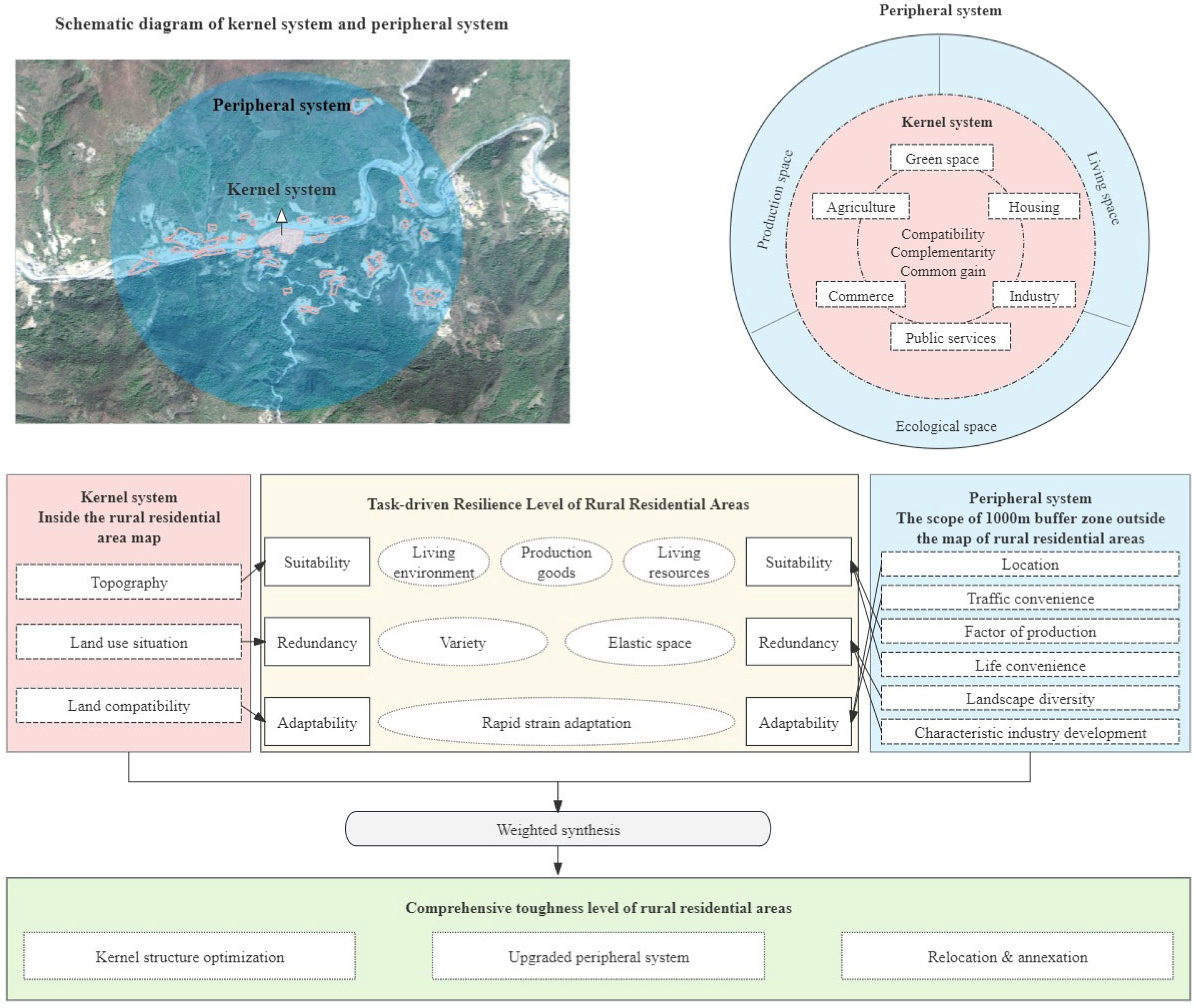
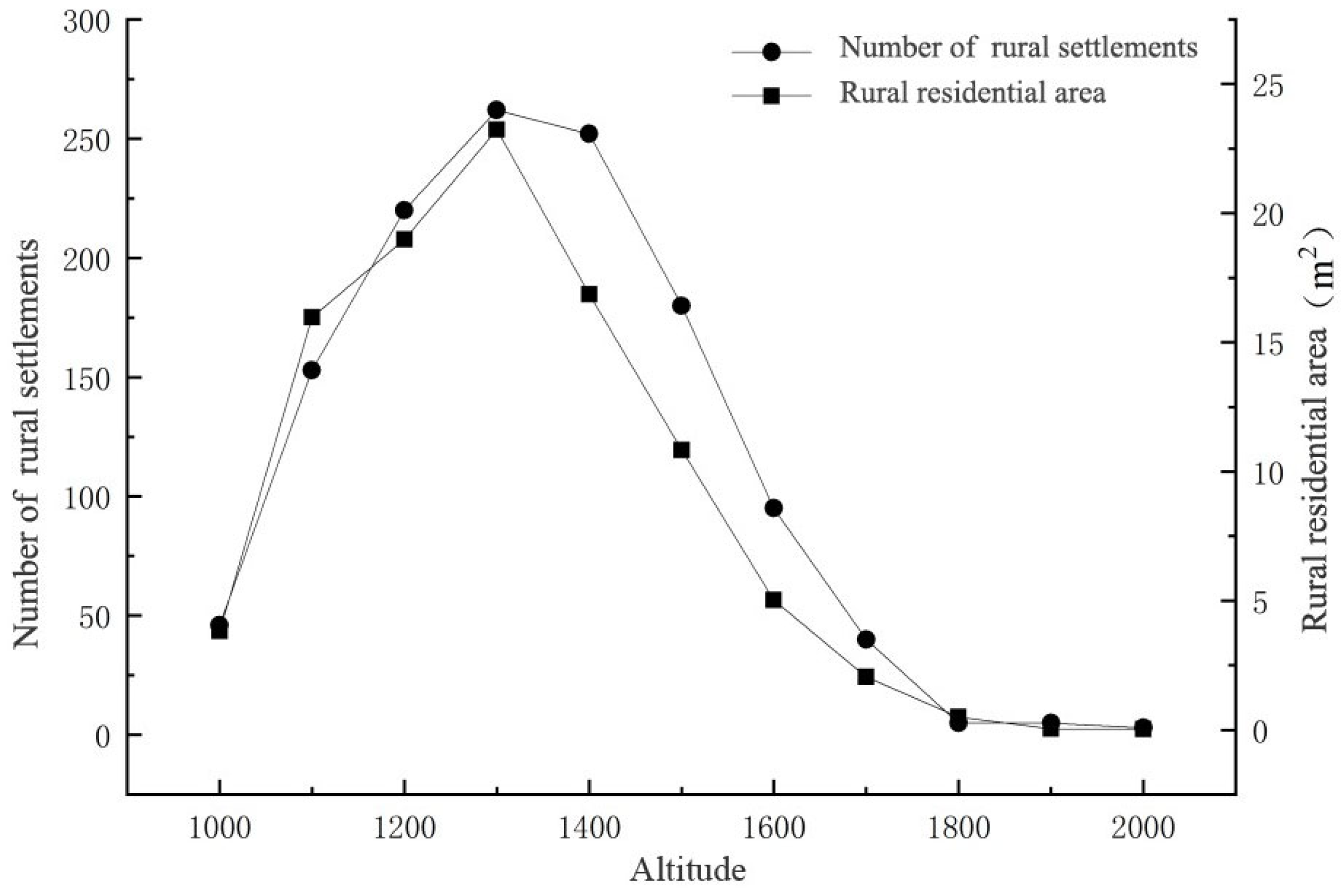
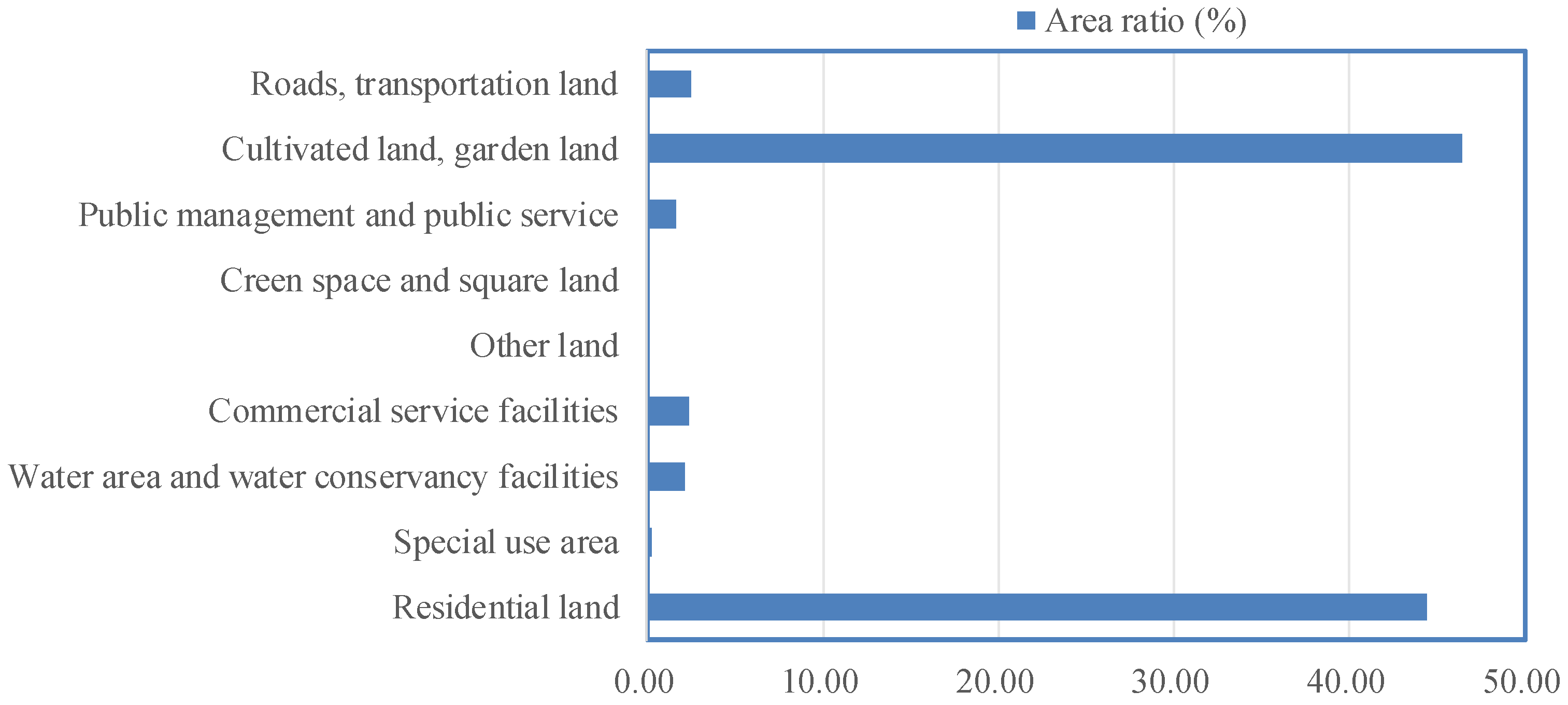
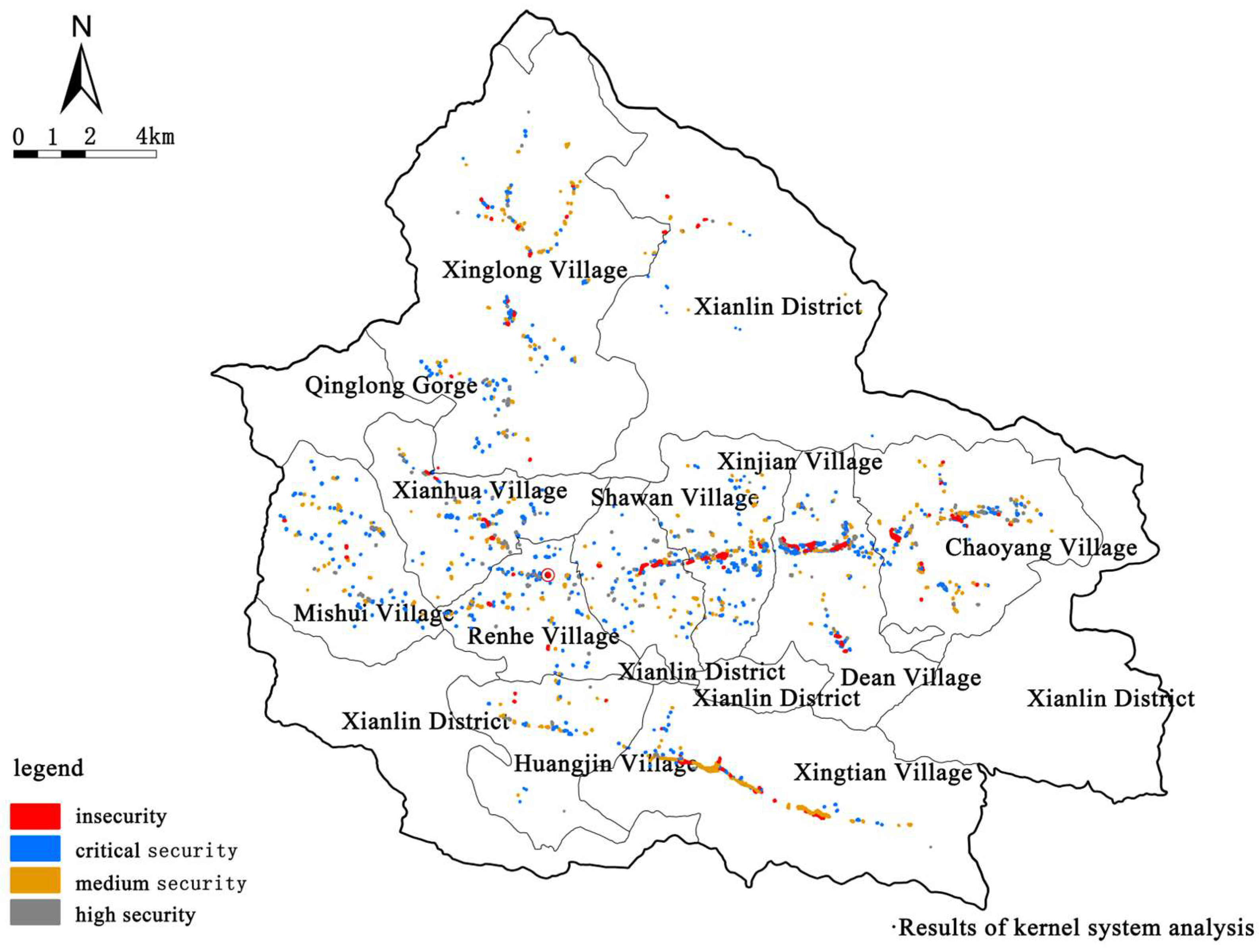
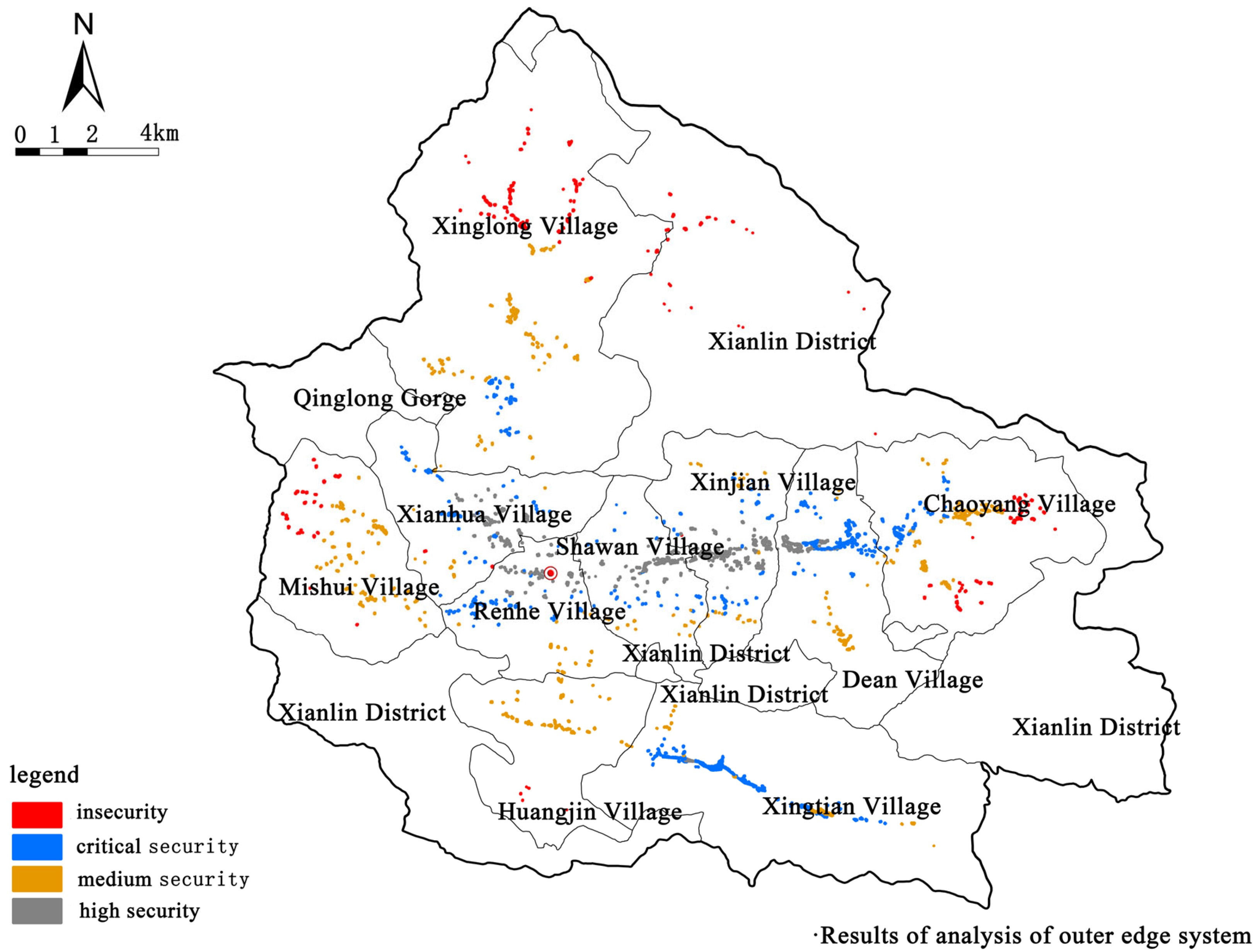
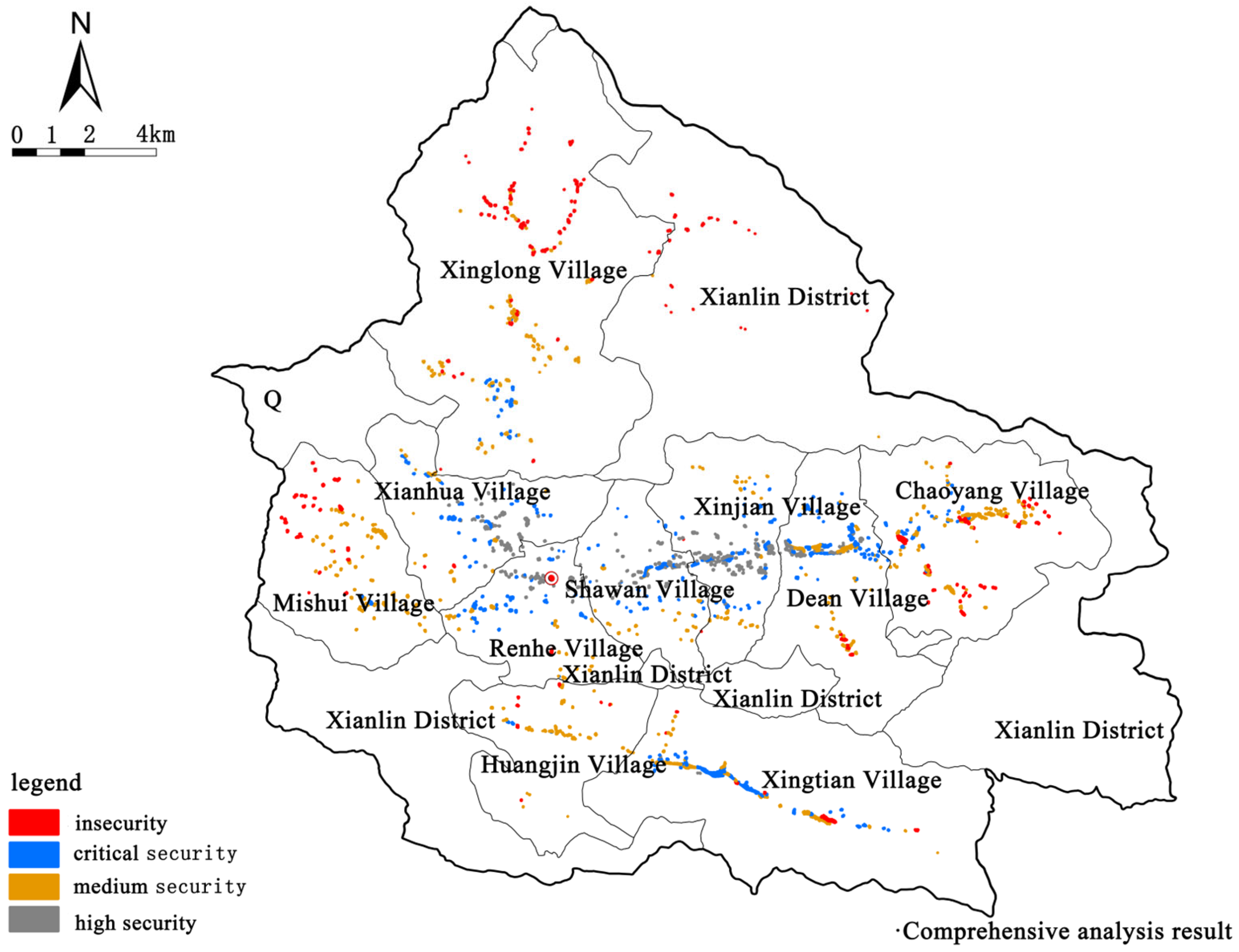

| Type | Data Name | Source | Remarks |
|---|---|---|---|
| Socio-economic data | Population | Statistical report of agricultural economy in 2020 | |
| Annual output value of primary, secondary and tertiary industries | Statistical report of agricultural economy in 2020 | ||
| Special industries | Statistical report of agricultural economy in 2020, Town government work report | ||
| Spatial data | Topography | DEM data of Chengkou county | |
| Township | Change survey data in 2020, Site location | Determine after data superposition | |
| Village Committee | Change survey data in 2020, Site location | ||
| Present situation of land use | Change survey data in 2020 | ||
| Economic crop planting | Change survey data in 2020, Provided by town government and village committee, Site location | Determine after data superposition | |
| School | Change survey data in 2020, Site location | ||
| Geological disaster point | Monitoring data of ground disasters in dong an town, Site location | ||
| Tourist reception facilities | Provided by town government and village committee, Site location | ||
| Road | Change survey data in 2020 |
| Target | Criterion Layer | Indicator | Weight | Attribute |
|---|---|---|---|---|
| Kernel system | Suitability | Terrain potential index | 0.150 | − |
| Redundancy | Site diversity index | 0.060 | + | |
| Adaptability | Land use compatibility index | 0.090 | + | |
| Peripheral system | Suitability | Production space proportion | 0.105 | + |
| The distance to the nearest school | 0.053 | − | ||
| Distance from the village committee | 0.052 | − | ||
| Geological hazard points | 0.140 | − | ||
| Redundancy | Distance from tourism reception facilities | 0.063 | + | |
| Sowing area of economic crops | 0.105 | + | ||
| Landscape Diversity Index | 0.042 | + | ||
| Adaptability | Distance from Township | 0.056 | − | |
| Road network density | 0.084 | + |
Disclaimer/Publisher’s Note: The statements, opinions and data contained in all publications are solely those of the individual author(s) and contributor(s) and not of MDPI and/or the editor(s). MDPI and/or the editor(s) disclaim responsibility for any injury to people or property resulting from any ideas, methods, instructions or products referred to in the content. |
© 2025 by the authors. Licensee MDPI, Basel, Switzerland. This article is an open access article distributed under the terms and conditions of the Creative Commons Attribution (CC BY) license (https://creativecommons.org/licenses/by/4.0/).
Share and Cite
Cao, W.; Yang, Q.; Liu, Y.; Liu, X.; He, H.; Yang, J.; Deng, Q.; Wang, Y. Research on Social-Ecological Resilience Assessment of Rural Settlements in Typical Mountainous Areas of Southwest China Based on the Coordination of Kernel and Peripheral Systems. Land 2025, 14, 2054. https://doi.org/10.3390/land14102054
Cao W, Yang Q, Liu Y, Liu X, He H, Yang J, Deng Q, Wang Y. Research on Social-Ecological Resilience Assessment of Rural Settlements in Typical Mountainous Areas of Southwest China Based on the Coordination of Kernel and Peripheral Systems. Land. 2025; 14(10):2054. https://doi.org/10.3390/land14102054
Chicago/Turabian StyleCao, Wei, Qingyuan Yang, Yan Liu, Xiaoyu Liu, Huiyu He, Jinrong Yang, Qiao Deng, and Yahui Wang. 2025. "Research on Social-Ecological Resilience Assessment of Rural Settlements in Typical Mountainous Areas of Southwest China Based on the Coordination of Kernel and Peripheral Systems" Land 14, no. 10: 2054. https://doi.org/10.3390/land14102054
APA StyleCao, W., Yang, Q., Liu, Y., Liu, X., He, H., Yang, J., Deng, Q., & Wang, Y. (2025). Research on Social-Ecological Resilience Assessment of Rural Settlements in Typical Mountainous Areas of Southwest China Based on the Coordination of Kernel and Peripheral Systems. Land, 14(10), 2054. https://doi.org/10.3390/land14102054








